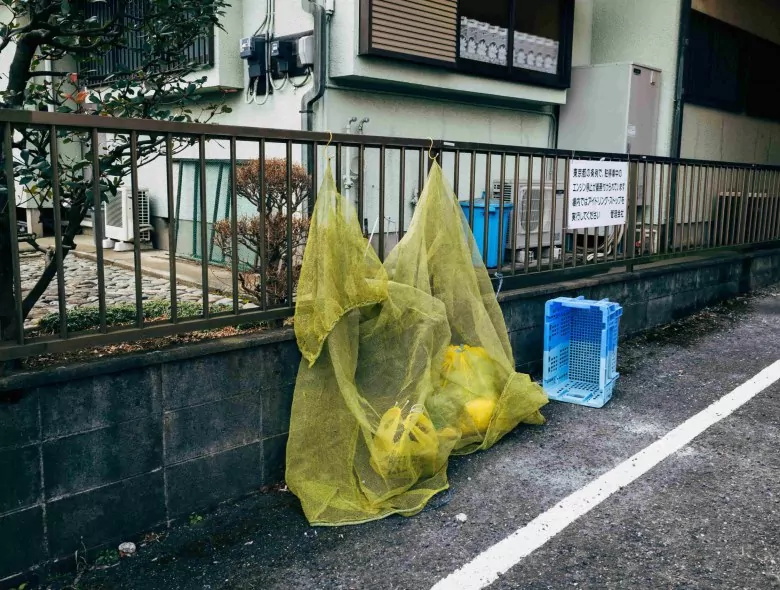Separating trash in Japan will vary from how you separate the trash in your home country. It’s one of the more unexpected challenges of moving to Japan. Recycling in Japan varies from town to town. If you can’t figure out the system of separating trash in Japan or your local garbage collection, please visit your city hall and they will be able to offer you the relevant information.

With excessive packaging and single-use plastics being very hard to avoid, recycling in Japan is all the more necessary.
You may have heard of the inspiring zero-waste town of Kamikatsu in Shikoku. For over 20 years the residents have been carefully separating their rubbish for garbage collections. It’s perhaps the most rigorous Japanese recycling system, where waste is separated into no fewer than 45 different categories. Your local recycling will probably be considerably easier than this though!
The four main categories of separating trash in Japan are combustibles (burnable), non-combustibles (not burnable), recycling, and oversized rubbish. Here we will focus on recyclables.

Bins and where to put your garbage
The designated recycling bins for the garbage collection may be in a different place to where you leave general waste, so be sure to read any signs.
Most likely, you won’t find bins to put your bin bags in either. Instead, the designated area to leave your rubbish out for the garbage collection usually has a net which you then use to cover up the pile of bin bags so that the crows don’t get to them.
If you miss the garbage collection or have a lot of recyclable waste piling up, various supermarkets have separated recycling bins where you can take your rubbish. At supermarkets, you’ll usually find a bin for aluminum cans, one for tin cans, and one for PET bottles.

Separating Trash in Japan
Do make sure that you’re aware of the different recycling categories, and don’t put any of the recyclable rubbish into the general waste. Recycling in Japan is taken seriously, and people adhere to the rules of garbage disposal, so it’s best to do as everyone else does and try to figure out the system of separating trash in Japan!
One of the more intimidating parts of recycling in Japan is that if the trash hasn’t been separated correctly, there’s a chance it could be refused from the garbage collection. For example, if you put a glass in the general burnables and it gets rejected, you will find yourself having to fish through old garbage to find the culprit.
We recommend having separate bins in your apartment or just making sure to separate your trash into the different categories as you go instead of having to do it at the garbage collection points.
Listed below are some of the different recyclable categories in the Japanese recycling system, these vary across Japan so please use this as a guide alongside the relevant information for your town.
Waste paper
This includes cardboard boxes, paper, paper bags, magazines, newspapers, envelopes, and leaflets. Any attached non-paper products (i.e.. plastic film on envelopes, sellotape from boxes) should be removed.
Usually, you will have to sort each type of paper by item (so putting gathering all the newspapers together in one bundle, and the magazines in another, etc.).
Waste paper should be arranged and put into bundles tied together by string, boxes need to be flattened before putting them into bundles.
Containers and packaging
Cartons, such as juice and milk cartons, should be rinsed with water and flattened for recycling. Cartons lined with aluminum aren’t normally recyclable.
Plastic containers and packaging trash consist of things like food trays, instant noodle containers, plastic egg cases, tofu containers, soap and shampoo bottles, and plastic bags. These should be cleaned
PET bottles (plastic bottles for drinks, soy sauce, vinegar, sake, etc) are separated from the rest of the plastic containers. PET bottles should be rinsed, and labels should be removed. You may also have to remove the lids of the bottles too.
Cans
Cans and tins should be rinsed through. Paper labels usually need to be removed as well. You may be able to recycle spray cans, but they need to be empty for the collection since they are explosive. Do not make a hole in the spray can.
Bottles
Glass bottles, including alcoholic drink bottles, jam jars, sauce jars, cosmetic containers, and seasoning jars also need to be rinsed. You should remove and lids or caps, however, if you can’t remove inner plugs and labels, they can be left.

Packaging in Japan
It’s no secret that products in Japan usually come heavily packaged in single-use plastics. Zero waste shops are popping up in Japan. Shopping at these kinds of stores will help to reduce your amount of waste, and with less to recycle it makes the problem much easier! Unless you find somewhere that sells produce free of packaging, you’ll still have to regularly deal with the Japanese recycling system!
Recycling beyond the Japanese recycling system
Although clothes and shoes can be disposed of in the combustible trash, please consider whether there is somewhere else you can take these materials for more recycling in Japan. If they are still in good condition, consider donating the clothes to a charity or Uniqlo, or selling them online or to a second-hand shop.
If your clothes can’t be re-worn perhaps they could still be recycled as raw materials, in this case, H&M will take them, and offer a ¥500 coupon for every bag of clothing donated.
The Japanese recycling system can seem intimidating at first, but don’t worry you’ll soon find it easy. Please make sure to visit your city hall since they will be able to help you find the designated spot to leave your trash, as well as the dates for the garbage collection and the different categories for separating trash in Japan, specific to your local area.



